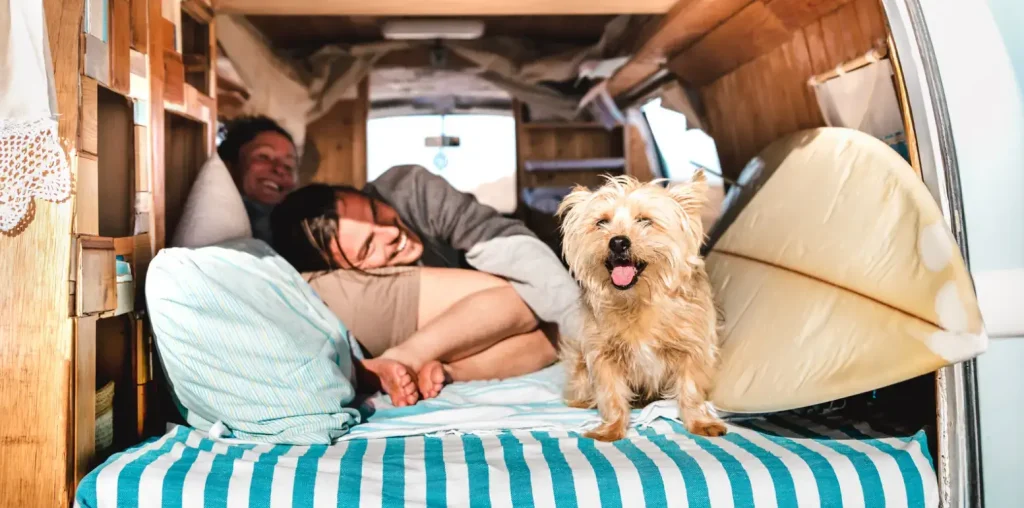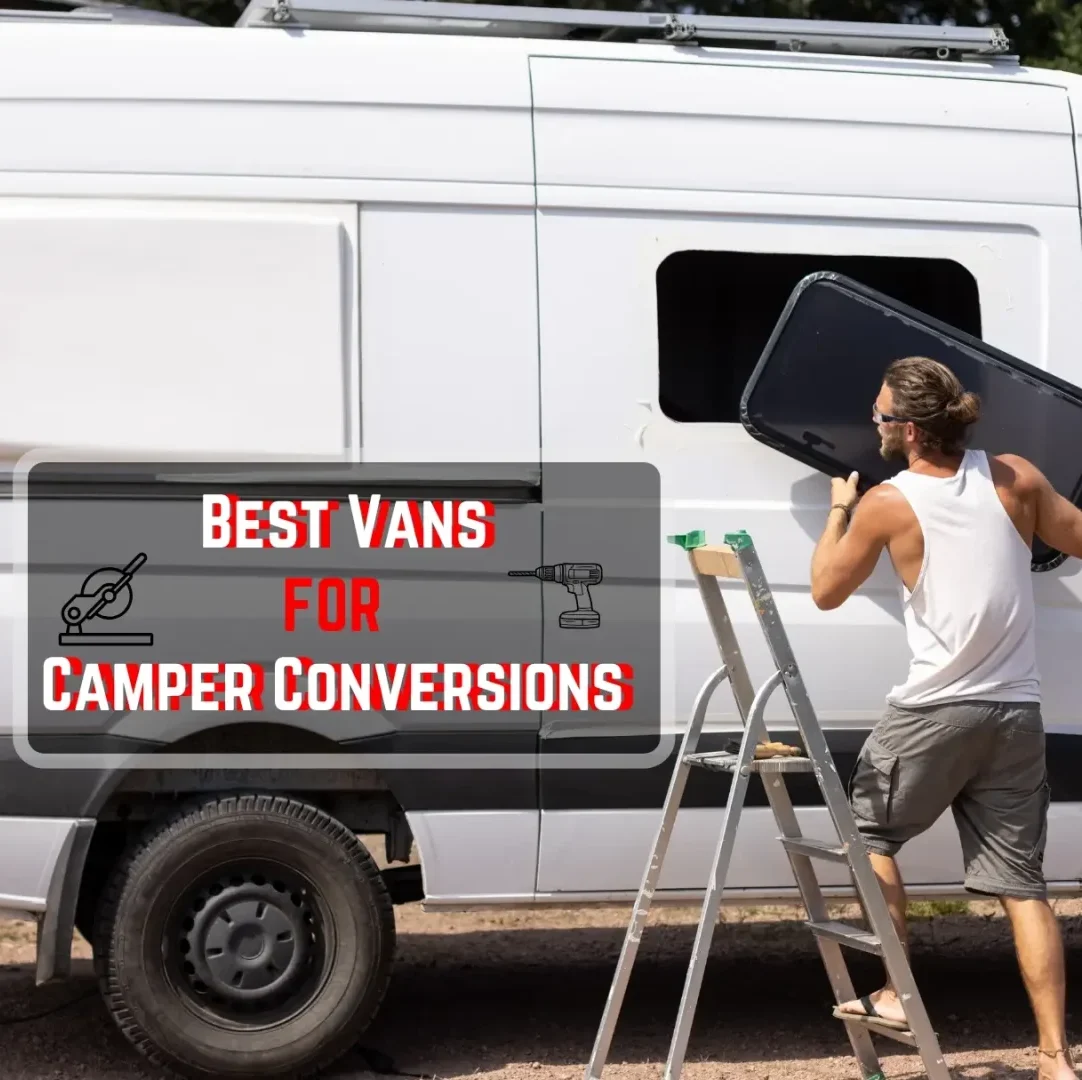You’re about to embark on a camper van conversion journey. The road is calling. Life is calling.
Freedom is calling.
But the real question is where do you begin? Budgets, project designs, conversion processes… And, of course, the conversion van itself. This begs the question-
What are the best vans for camper conversions?
That’s what we’re looking at today! The BEST vans for the project ahead. We’re examining from the angle of both:
- What’s the best model for the van conversion process itself…
- As well as what’s the right model for your new life…
The van life!
The van life is my bread and butter, so it’s time for a snack of knowledge. The last thing you want is to buy a crummy van and seven years later still be trying to figure out how to get the damn thing converted while stuck in the hometown you never left.
With this expert guide, getting a campervan conversion done is no longer your white whale. Just a regular, ol’, delectable fish.
Let’s find you the best van for your camper conversion dream.
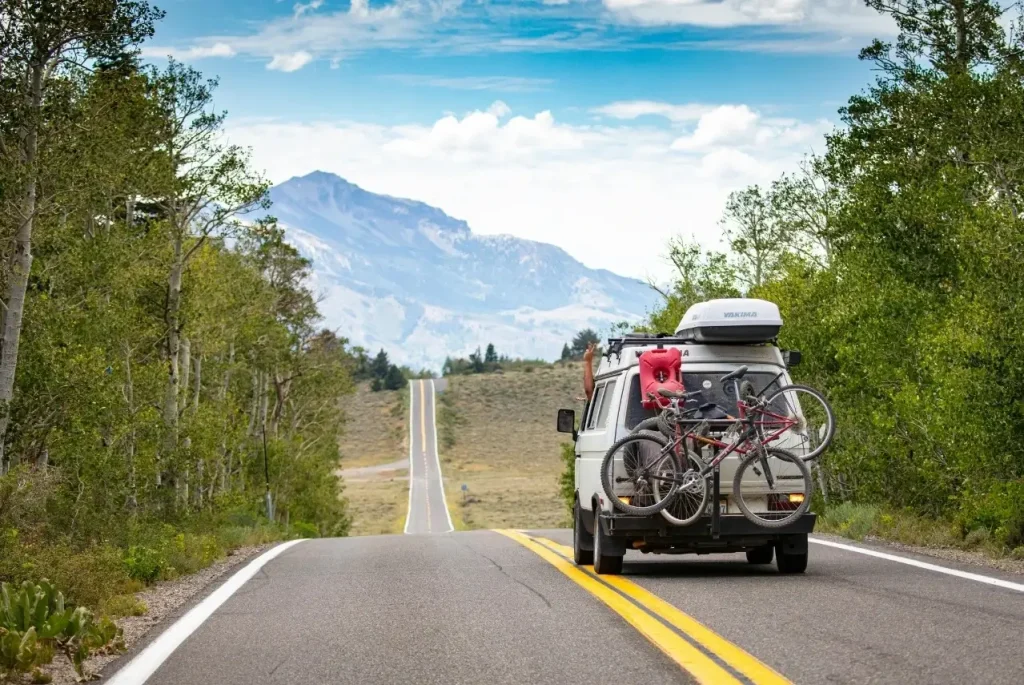
What You Need To Consider Before Exploring Van Models for Conversions
Before diving headfirst into van shopping, we need to define what constitutes the right van.
A dream custom van conversion isn’t just about aesthetics. It’s about practicality. Reliability. Whether your chosen van model fits your budget, lifestyle, and long-term plans.
Here’s what it’s crucial to consider BEFORE you go buying any freedom-mobiles.
Your Total Budget
Your budget for a conversion van is your starting point. This is for both the van itself as well as the overall camper conversion project.
Do you want a budget-friendly DIY build? Or a fully kitted-out professional job? The cost of purchasing the van is just one part of the equation. The cost of the van conversion is part two:

- Used vans: Expect to pay anywhere from $5,000–$25,000, depending on the van’s age, mileage, condition, and model. The low end of that range tends to get you high-mileage workhorses. The higher end will score you something much closer to a new van.
- New Vans: For a brand new beast, you’ll pay somewhere in the $30,000–$50,000+ range, per your proclivity for premium features. While the initial cost for a new van is much higher, you’ll have lower maintenance costs for some time and likely a warranty. (Plus a much lower quote if you sign up with a trustworthy extended RV warranty provider after the manufacturer’s period expires.)
- Conversion Process: If you’re outsourcing the build to professionals, you should be prepared to spend at least $30,000–$100,000+. This range varies greatly depending on what you want, the size of your van, and if you’re able to hybridize any of the professional work with your own efforts.
Meanwhile, for a DIY conversion, plan a budget of $5,000–$15,000. This will cover materials, appliances, and tools (plus the months of elbow grease).
Whether you choose a new or used van and DIY or professional camper conversion, one thing is true: it ain’t cheap! However, if you look at the low end of those ranges, it’s still more than affordable.
All it takes is a hustler mindset and commitment to the OG spirit of the van lifestyle!
The Van’s Mileage
Mileage isn’t just a number—it tells a van’s story. A low-priced, high-mileage van might look like a great deal, but only if it’s got a reliable reputation and service history to match.
- High-mileage vans (150,000+ miles) are cheaper but need more upkeep. That said, models like the Mercedes Sprinter and Toyota Hiace are known to hit 300,000+ miles if they’re well-maintained vans.
- Mid-mileage vans (80,000–150,000 miles) give a balance between cost and reliability. Look for models trusted by van life enthusiasts, like the Ford Transit or Dodge ProMaster, with a solid maintenance history.
- Low-mileage vans (<80,000 miles) will be pricier. But if your budget allows it, they generally have a lot of gas left in the tank.
Reliability and Ongoing Maintenance Costs
All that said, mileage doesn’t mean much if the van hasn’t been well-kept. Often, campers with great reputations and glowing service histories can trump even the most popular van models.
Always request service records before purchasing a van for conversion. Consistent general services, transmission work, repair history, and timing belt replacements are key indicators of a well-maintained van.
Furthermore, ask around and do your research. Not all vans are created equal.
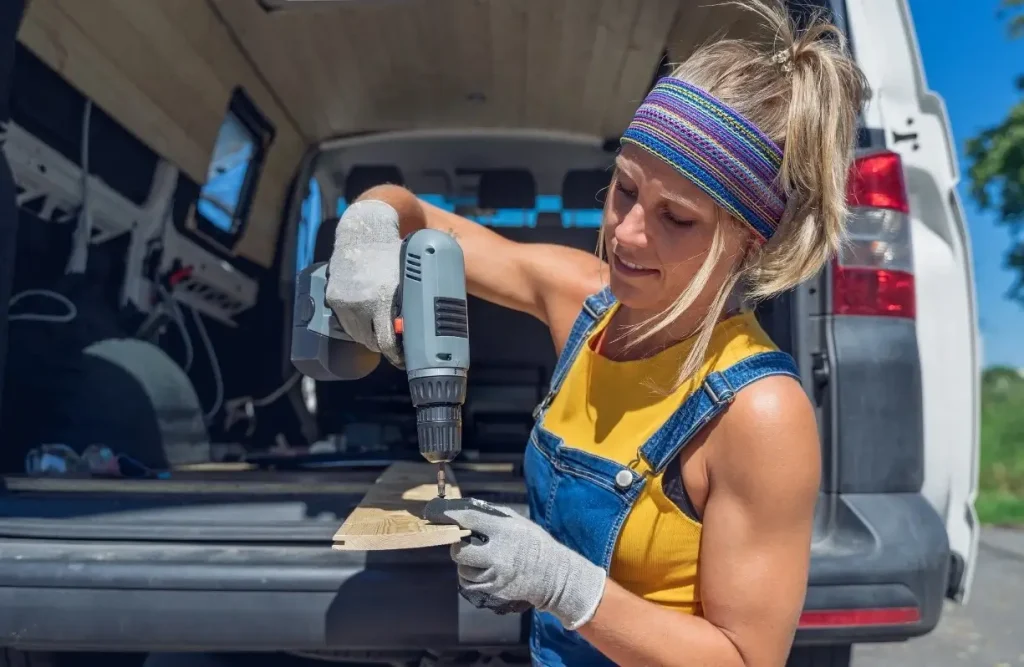
For example, Toyota Hiaces, Ford Econolines, Mercedes Sprinters, and Chevy Expresses are all known for reliability and low-maintenance needs. Meanwhile, the classic and beloved old Volkswagen models actually have a reputation for being total divas.
We’re looking at the best vans for camper conversions in this article, so we’ve factored in reliable reputations. You won’t find any Liberaces on this list! Only Eastwoods.
Rugged, resilient, and built for the miles ahead.
The Van’s Size, Storage Solutions, and Roof Height
Small vans seriously limit your storage space and livability. This can be crippling as space efficiency and using storage wisely in vans and RVs is key to the lifestyle. However, the maneuverability and capacity for stealth camping of smaller vans are unmatched.
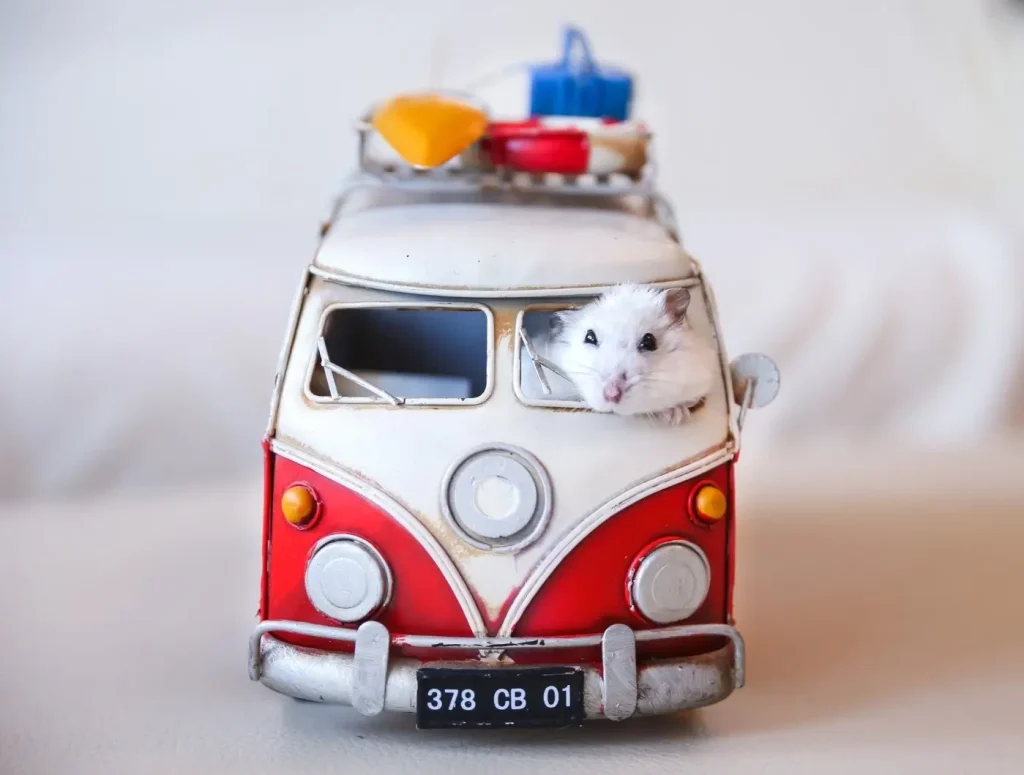
Meanwhile, large vans with spacious interiors give you a lot more freedom. Ample space is a lot more suited to full-time living and different setups, like internal kitchens and bathrooms. But driving through urban areas and finding cheeky park-ups does get trickier.
Also, consider the van’s roof height. A high-roof van (6′ or taller) lets you stand up inside, while a low-roof model forces you to crouch. If compact is the way you want to go, consider installing a pop-top roof to compensate for the low height.
The Van’s Fuel Efficiency
Gas mileage matters! The better the mileage, the lower the ongoing costs of your life on the road.
Small vans also help in this regard. For example, the Ford Transit Connect or Nissan NV200 are lean, mean, compact machines built for fuel-efficient weekend getaways. (But not so much long-term expeditions.)
Generally speaking, fuel mileage looks like:
- Fuel-efficient vans give you 20+ MPG.
- Moderately efficient vans are achieving closer to 15–20 MPG.
- Gas guzzlers are pulling maybe <15 MPG.
Keep in mind that adding weight (e.g. solar panels, water tanks, heavy furniture, etc.) reduces your fuel mileage. Plan accordingly.
The Resale Value
Unless you’re determined to run your converted camper van into the ground, consider its resale value too. Some vans, like a Mercedes Sprinter van conversion or a long-wheelbase Toyota Hiace, hold their value hard. Different van models might depreciate more quickly.
Moreover, professional campervan conversion, especially from reputable van builders, achieves higher resale. DIY jobs are generally hit-or-miss on the aftermarket unless you did a damn sexy job.
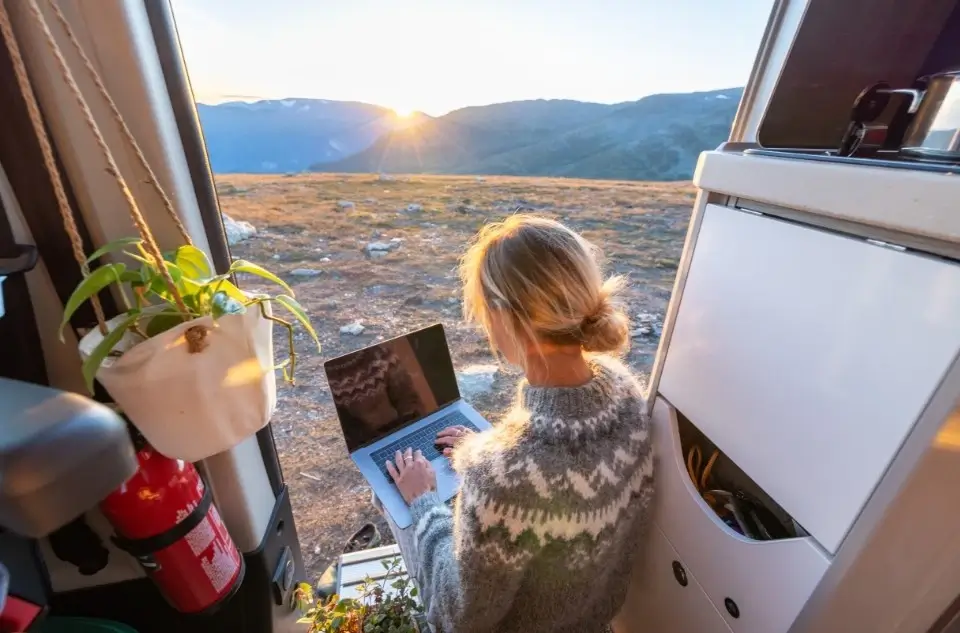
The simpler, more functional, and less personalized your camper conversion is, the higher the resale you’re likely to get. That said, don’t sacrifice too much personality! While planning how to sell your camper for the optimal resale value is never a bad thing, enjoying the RV life should be the primary goal.
It’s your dream lifestyle, after all. 🙂
DIY Jobs vs Professional Conversions
To commission van builders or to get your hands dirty? That is the question!
A DIY van conversion is always going to be cheaper. You’ll learn new skills, be in full control of the final product, and have the know-how to solve most problems when they arise later down the line.
But a professional job is a professional job. High prices come with high-quality work. They also usually involve warranties and a helluva lot less stress.
The choice is about budget, yes. But it’s also about all your resources. Even the best vans to convert will still take an enormous amount of time, mental energy, and emotional investment. If you don’t have that to spare (plus the skills to do it), there is ZERO shame in paying someone who does to manage the conversion process for you.
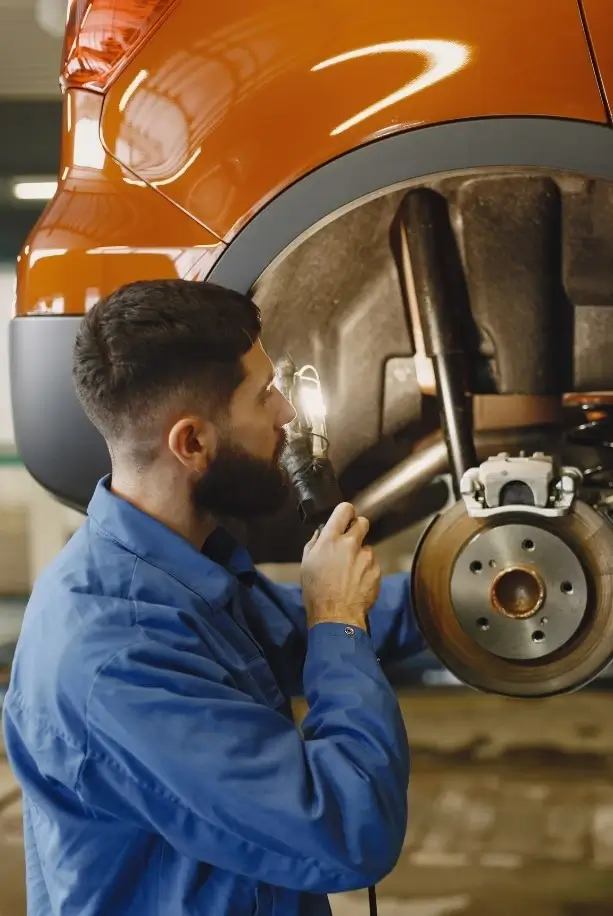
Or, take the middle road! DIY what you can like hard labor and some carpentry or upholstery. Then, delegate the hard stuff to a conversion company, e.g.:
- Propane lines
- Electrical systems
- Plumbing and water-based fixtures
- RV air conditioning units
- Or heating systems
These are particularly tricky areas where one small mistake can cost you big. Sometimes, it’s better to just not take the chance.
The hard road or the shortcut, it doesn’t matter! Whatever gets you out there on the road sooner.
The 5 Best Models of Vans to Convert to a Camper
Speaking of the road, let’s roll!
Now you know the key considerations. But the question still remains…
What are the best vans for camper conversions?
Not all vans are built equally. Every “best” van to convert brings something a little different to the table. So whether you’re after modern features, ample cargo capacity, or just an easy project, let’s find the right van for you!
Best Overall
1. Ford Transit Van
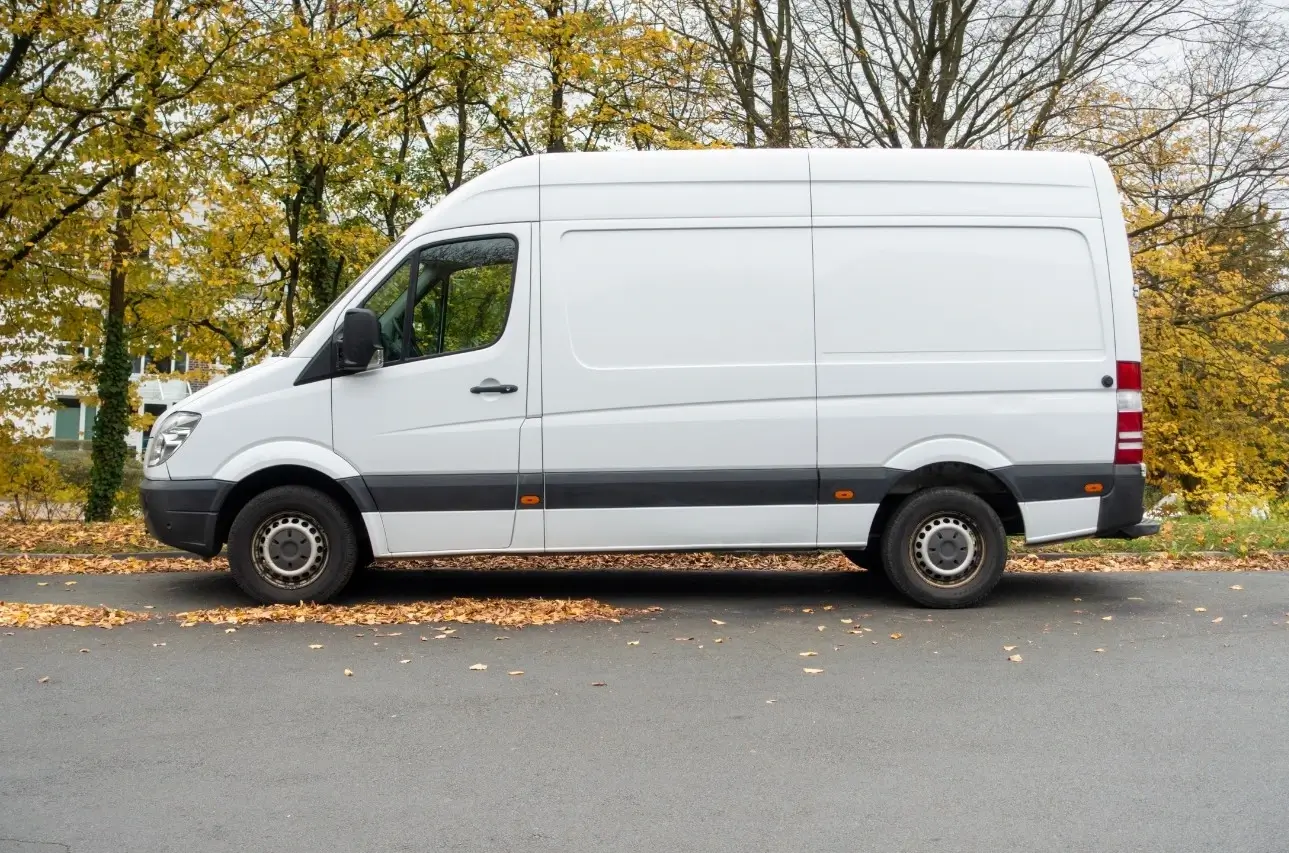
- Drivetrain: RWD / AWD (2020+ models)
- Roof Height: Low / Medium / High
- Max Length: 290″
- Fuel Efficiency: 15–20 MPG
- Price: $$
Let’s start with the all-around heavy-hitter. If you’re looking for the best of all worlds—affordability, interior space, versatility, and reliability—the Ford Transit is the van for you!
It’s modern. It’s widely available across the USA. And it offers multiple height and length options fit for different conversion styles. DIY build or pro camper conversion, the Ford Transit van can be molded into just about anything.
Ford Transit van conversions are a staple of the vanning space. However, it’s not because it necessarily excels in any one area. It’s because it hits high marks in ALL areas.
Variety is one of the Ford Transit’s biggest strengths You can choose from three roof heights, plus a whopping four lengths:
- Short Wheelbase (SWB): 220″
- Medium Wheelbase (MWB): 237″
- Long Wheelbase (LWB): 263″
- Extended Length (ELWB): 290″
The Ford Transit also delivers very competitive fuel efficiency for its weight class. But the biggest win, for American readers, is its pure availability. As mentioned, Ford Transit van conversions are a gold standard in the US (not to mention widely used as commuter vehicles). Parts and repairs can be found basically anywhere across the 50 states.
If you’re a fan of the off-grid boondocking lifestyle, be warned this isn’t the most off-road capable camper van on our list. While the all-wheel drive (AWD) models in circulation since 2020 help, it’s still not built for unsealed madness. But on-road, it rides like a dream (home).
In USA markets, the Ford Transit is by far one of the best vans for camper conversion for all-around part-to-full-time living. Affordable, spacious, and stylish, it checks every box.
Best Luxury
2. Mercedes Sprinter Van

- Drivetrain: RWD / AWD / 4×4
- Roof Height: Standard / High
- Max Length: 274″
- Fuel Efficiency: 18–22 MPG (diesel) / 14–18 MPG (gasoline)
- Price: $$$
Let’s talk luxury. For high-end camper van conversions, the uber-popular Mercedes Sprinter sets the bar sky-high. With its premium quality, technical modern features, and superior diesel efficiency, this van has earned its stalwart reputation as the go-to choice for luxury van life enthusiasts.
Rugged, reliable, and robust: the three R’s of the Mercedes Sprinter van conversion! This van has oodles of interior space to play with for conversions. Moreover, it has, a ridiculous fuel mileage in its diesel format, and a reputation for unparalleled longevity. (More than 300,000 miles with proper maintenance!)
In contrast to the Ford Transit, the Sprinter van also has excellent off-road performance. Newer AWD models do just fine off-grid. However, if you can get your hands on one through second-hand markets or imports, the 4×4 model is an absolute beast on rough terrain. Swap out the factory set for some high-quality, road-ready RV tires, and the off-roads will be your playground.
Beyond that, it’s a luxury purchase for a camper conversion. The Mercedes Sprinter is hyper-expensive with brutal repair costs and the features to match. Everything from heated seats to advanced driver assist and safety features is on display. It even boasts a modular-style conversion-friendly cargo van design, sealing the Sprinter as one of the best vans to convert for a glamped-up life on the road.
If you can afford it, you won’t be uncomfortable. Moreover, Sprinter vans hold their resale value incredibly well, so it’s a sound investment. Just be sure you’re ready to foot those maintenance bills.
Best DIY
3. Ram ProMaster Van
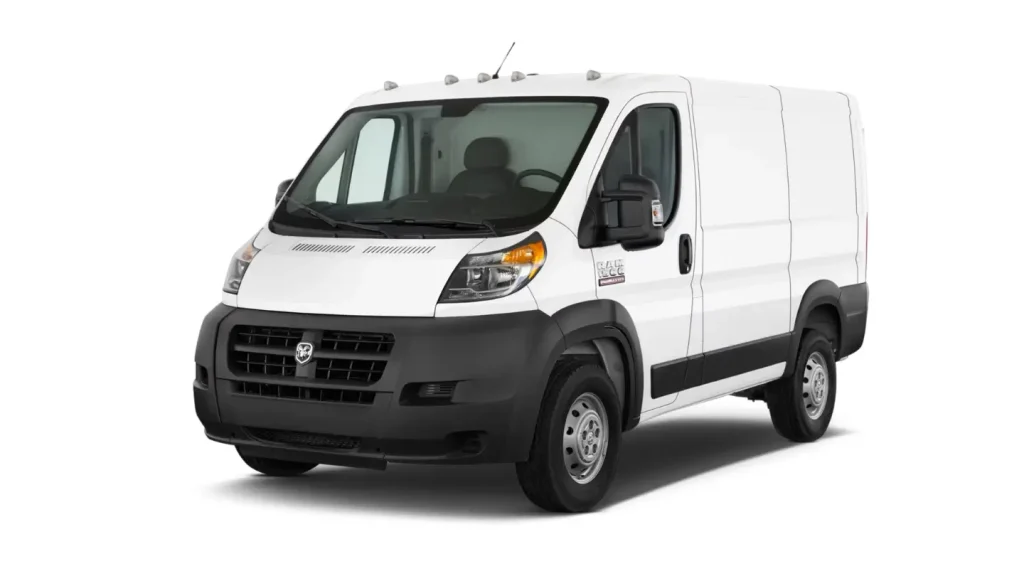
- Drivetrain: FWD
- Roof Height: Standard / High
- Max Length: 250″
- Fuel Efficiency: 14–18 MPG
- Price: $$
If you want to move away from Euro-centric designs and back to all-American class, the Ram ProMaster is the cargo van to convert. Size jokes aside, there’s a reason this is one of the best vans to convert for DIYers. It’s a dream to work with.
Maximized interior space and an easy-to-convert layout define the Ram ProMaster. With a best-in-class width and nearly vertical walls, DIY conversion processes are a lot simpler, even compared to modular cargo van designs like the Sprinter. There are no awkward curves or wasted space. If you want to install a large replacement RV mattress or even a full-size bed, this is one of the only van conversions that allows it without extensions.
Further design tweaks also maximize its spacious interior. As a front-wheel drive (FWD) van, the floor height is lowered for even easier standing. I’m also a fan of the super wide sliding door. This makes loading and unloading gear (as well as designing a great indoor-outdoor flow) a cinch.
Unfortunately, the FWD-only design means there are no AWD or 4×4 options like the Ford Transit or the Sprinter. The ProMaster still performs well in slippery conditions. But it will struggle on rough terrain.
Overall, there are a couple of areas where other vans perform better, such as resale and reliability. But nonetheless, the Ram ProMaster is a mid-range performer that more than pulls its weight. It’s a space-efficient large van with excellent width and several other nuances that make it an easy choice for DIY camper conversion projects.
Best Budget
4. Ford Econoline E-350/E-250

- Drivetrain: RWD
- Roof Height: Standard
- Max Length: 231″
- Fuel Efficiency: 10–15 MPG
- Price: $
Want something that’s cheap, tough, and reliable? Then the Ford Econoline is a no-brainer as a campervan conversion. It’s old and discontinued, sure. But it’s still widely available for cheap on the second-hand market. Moreover, it’s built like a tank.
Despite only being available as used vans, the Econoline’s legendary reliability is what keeps it so strongly in the game. It boasts a stout V8 engine alongside a reputation for lasting more than 300,000 miles. More than that, there are a handful of other factors that cement its reputation as an affordable, trustworthy workhorse:
- A heavy chassis
- A high payload capacity
- Excellent towing capacity
- And a wide, long, straightforward interior design perfect for conversion vans
Upfront prices are cheap (usually in the $5,000–$15,000 range). Repair and maintenance costs are low too, thanks to the Econoline’s no-nonsense mechanical design and massive availability on the second-hand market. They, unfortunately, do chug more gas than I’d prefer. Plus the lower roofs won’t be perfect for everyone.
But if budget and reliability were priorities for you over A+ comfort, the Econoline is perfectly aligned with the true spirit of the van life. Resourceful, self-sufficient, and simplicity over consumerism, may the dirtbag days never die.
Best Reliability
5. Toyota Hiace
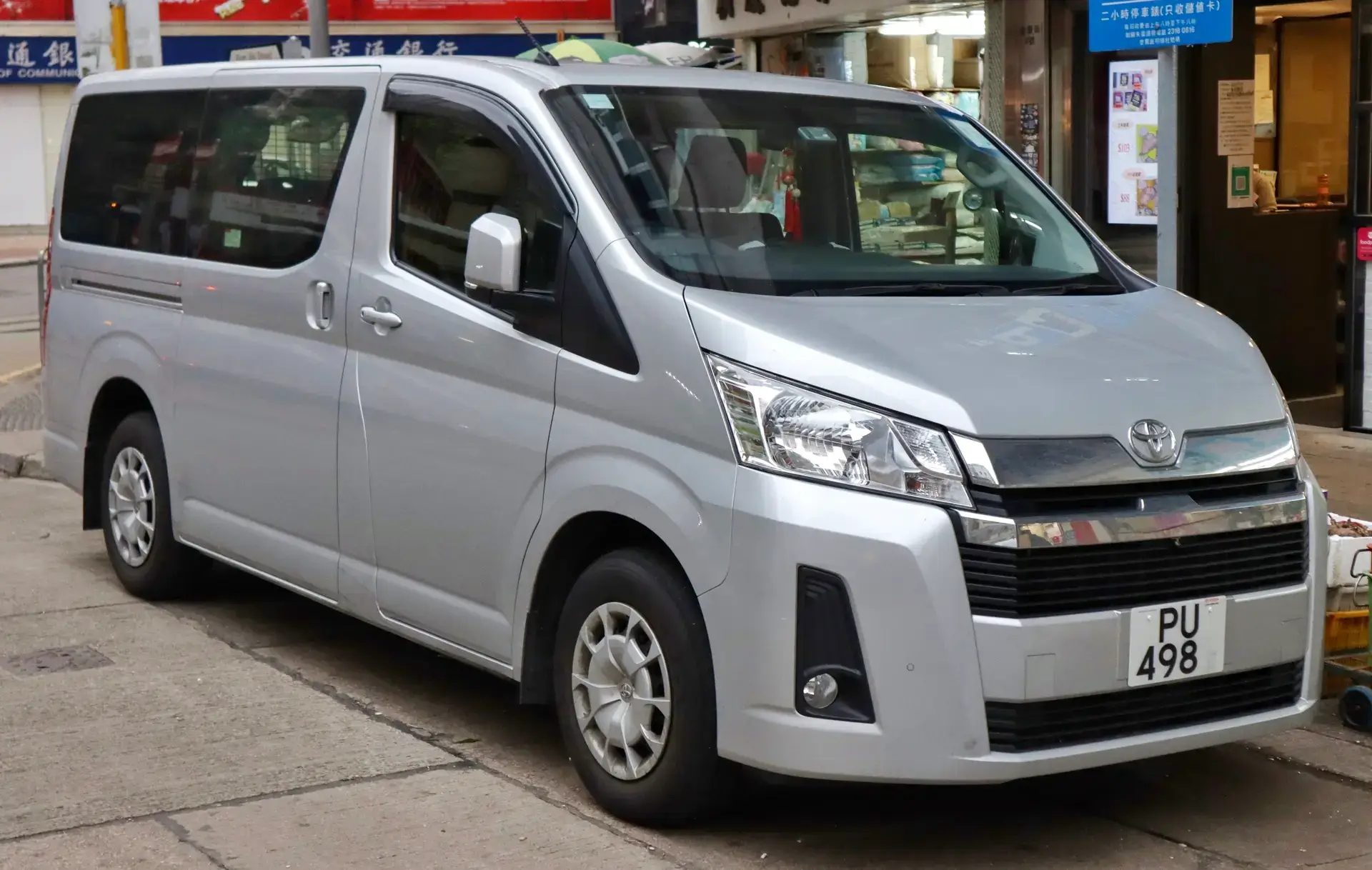
- Drivetrain: AWD / 4×4
- Roof Height: Standard / High
- Max Length: 210″
- Fuel Efficiency: 18–22 MPG (diesel) / 15–18 MPG (gasoline)
- Price: $$ ($$$ with US imports)
Ok, I threw the Toyota Hiace in here primarily for international readers. Unless it’s second-hand or you’re paying big for an import, the Toyota Hiace is very hard to get in the States. However, in international markets, it’s the gold standard for campervan conversions and the van life itself. Nothing quite matches the Hiace in rock-solid reliability and all-around terrain versatility.
Roomy, but not so big you lose maneuverability. Great on rough roads and in urban areas alike. And honestly, just an all-around reliable machine with excellent fuel efficiency and engine longevity. This thing often exceeds even 400,000 miles.
It’s honestly a real shame that import restrictions and automotive lobbyists have kneecapped the Hiace in American markets. In places around the world with much more dangerous and challenging terrain, such as the Australian Outback, Middle-Eastern and Sub-Saharan deserts, and jungled mountainscapes of Southeast Asia, the Hiace is one of the most popular vans models around. It’s the undisputed the undisputed champion of transport AND van life.
The AWD on the standard model is road-ready for most tricky environments. Meanwhile, the factory 4×4 models are built for more hardcore adventures. Realistically, the only downside is its scarce availability in the US. Plus, even in its extended long-wheelbase form, it’s not as big as the other vans on this list.
But the Hiace wasn’t made for luxury living. It was made for chucking a bed, a portable toilet, and a top-notch RV battery system in… Then hitting the road!
For pure, unadulterated, adventure, the Totoya Hiace is hands-down the best van for a camper conversion. Period.
The Best Vans for Camper Conversions: Quick Comparison
| Van Model | Drivetrain | Roof Height Options | Max Length (inches) | Fuel Efficiency (MPG) | Resale Value | Price | Best Feature | Biggest Drawback |
|---|---|---|---|---|---|---|---|---|
| Ford Transit | RWD / AWD (2020+) | Low, Medium, High | 235 | 15-20 | Moderate | $$ | Great balance of affordability, space, and availability | Not great on rough roads, no factory 4x4 option |
| Mercedes Sprinter | RWD / AWD / 4x4 | Standard, High | 274 | 18–22 (diesel) / 14–18 (gas) | High | $$$ | Premium quality, great fuel economy, holds value well | Expensive to buy and repair |
| Ram ProMaster | FWD | Standard, High | 250 | 14-18 | Low | $$ | Best interior width for conversions, easy DIY build | No AWD/4x4 option, low resale value |
| Ford Econoline | RWD | Standard | 231 | 10-15 | Low | $ | Cheap, easy to repair, widely available (used) | Discontinued, bad mileage |
| Toyota Hiace | AWD / 4x4 | Standard, High | 210 | 18-22 (diesel)/15-18 (gas) | High | $$ / $$$ (USA) | Legendary gold standard, reliable, off-road ready | Must be imported into the USA |
Van Conversion Costs: How Much Do You Need?
Ok! On the note of costs for van conversions, let’s recap those numbers real quick:
- Professional Camper Conversions: $30,000–$100,000, though can often easily exceed $150,000.
- DIY Camper Conversions: $5,000–$15,000, though, again, exceeding that to $20,000 or even $25,000 is very possible.
Now, let’s break those DIY conversion costs down in detail. Looking at appliances, systems, and materials, figures tend to range from…
- $500–$1,500 for insulation and flooring.
- $1,500–$5,000 for an electrical system with solar and/or an inverter.
- $500–$2,000 for a simple plumbing setup, e.g. fresh and grey water tanks, a good-quality RV water pump, and a sink).
- $1,000–$5,000 for kitchen essentials like a fridge, stove, cabinetry, and any appliances (like a coffee maker!).
- $1,000 – $3,000 for a bed, storage solutions, and the general interior buildout.

As mentioned, you can also hybridize the conversion process! For those going half DIY, half pro, prices will vary wildly depending on your approach. However, $15,000–$50,000 is a fair range, depending on what you handle. Per systems, professional conversion costs generally look like:
- $3,000– $10,000 for a solar and battery system installation.
- $2,000 – $5,000 for plumbing and water setup.
- $5,000–$15,000 for custom cabinets and furniture.
Lastly, you always have the option of conversion kits. These kits, coming in several variations, essentially bundle the materials, components, or appliances you need into one convenient camper conversion package:
- Basic Kits | $500–$3,000 | Usually only include basic materials and pre-cut pieces for assembly, such as bed platforms, shelving, and insulation.
- Modular Kits | $2,000–$10,000 | Only buy the component you need, e.g. a kitchen unit kit or a storage and shelving kit.
- Full Conversion Kits | $8,000–$30,000+ | Generally includes everything you need for an entire campervan conversion.
- Luxury Kits | $15,000–$50,000+ | The full kit plus high-end gear, like fancier furniture, advanced solar setups, and climate systems like AC.
Whichever way you go, there are always ways to keep prices down. However, it takes a little hustle and a little grit. Remember to weigh up your budget against your penchant for massive time and energy investments.
The van life should be about self-sufficiency, sure. But primarily, it should be about fun.
Legal and Insurance Requirements to Convert a Camper Van
Righto—red tape! Converting a van into a camper in the USA comes with legal and insurance hurdles. Unfortunately, those requirements vary by state and can be a headache to dissect.
In many cases, you’ll need to reclassify your van as an RV to qualify for specialized insurance. It’s a pain, but it’s the only way to properly cover all the must-have RV gear and essentials you loaded into your ride. In some states, RV certifications may also cost an extra fee, usually between $200 and $1500.
Though state-to-state rules differ, acquiring RV certification for a converted van usually requires at least:
- A permanent sleeping area, kitchen, and storage.
- Proof of modifications, such as receipts and photos.
- An inspection at the DMV or by a certified third party.
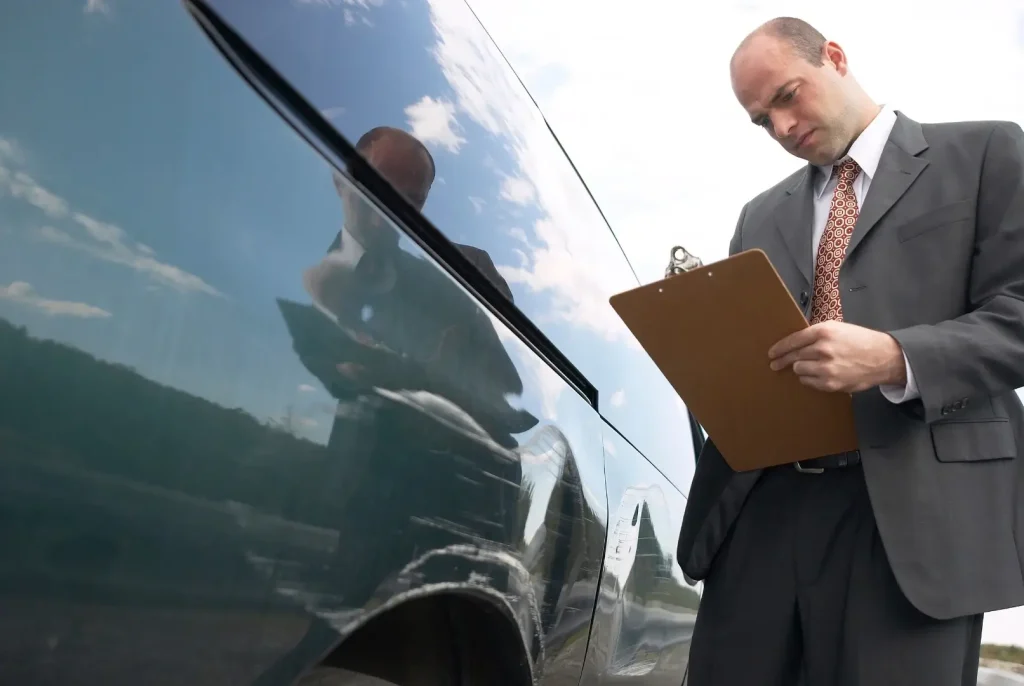
For insurance, many standard auto policies won’t cover DIY camper conversions. You’ll need to look into RV insurance from more tailored companies like Progressive, Geico, or State Farm. Other insurers may require a professional conversion, or at least specific safety features to be installed like ventilation, fire extinguishers, and carbon monoxide detectors.
State-specific regulations may also impose emissions, weight, or zoning restrictions on various aspects of your van life. Things like parking and overnight stays can be affected by your camper conversion’s specifications. Always check with your local DMV and insurer to avoid unexpected bureaucratic roadblocks when converting your van. (And online resources of state-based regulatory conversion info.)
FAQs About Camper Van Conversions
Even the best vans for camper conversions still come with questions! It’s a fun process, but nobody ever said it was simple.
Let’s plug these last holes and hit the road!
What is the cheapest van for a camper conversion?
The cheapest models for camper conversions are high-mileage older vans, albeit ones with steadfast mechanical reliability. Alongside the Ford Econoline (E-350/E-250) featured on this list, the Chevy Express, and Dodge Ram Van are other great budget picks for a camper conversion. Just keep in mind that older, used vans generally require more repairs and fuel compared to modern, fuel-efficient options.
What is the best van to convert for a family of 4?
For a family of four, you’ll need space, sleeping arrangements, and storage. Full-size vans like the Mercedes Sprinter or the Ford Transit with extended wheelbases and high roofs are great options. All that said, for comfortable living on the road as a family, I would suggest looking into other classes of RVs. Something like a Class C or compact Class A is much more enjoyable for traveling groups.
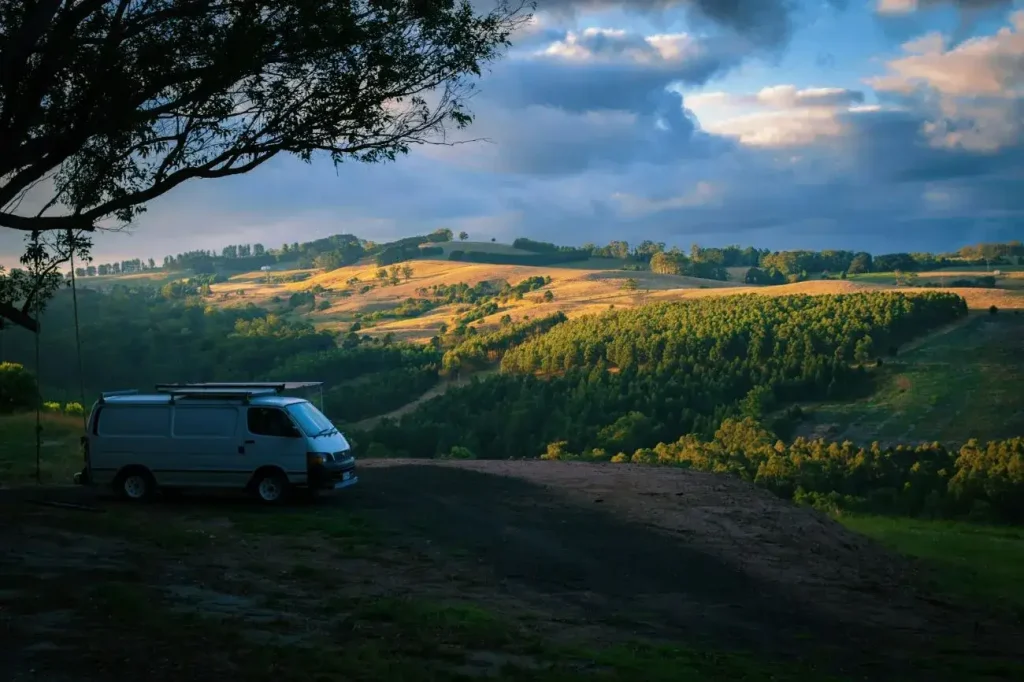
What is the most reliable van for camper conversion?
If reliability is your key concern, the Toyota Hiace is the undisputed king. Known for legendary durability and off-road capability, HiAces routinely hit 400,000+ miles with proper maintenance routines. However, given how tricky they are to acquire in US markets—which can really hurt the availability of good maintenance and repair processes—both the Ford Transit and Mercedes Sprinter offer viable choices alternative choices for US-based buyers.
How much does it cost to convert a van into a camper?
Conversion costs vary widely, but here’s a rough breakdown:
- DIY camper conversions typically range from $5,000–$15,000, but are easily capable of pushing up to $20,000+.
- Hybrid camper conversions (DIY + professional help) generally cost around $15,000–$50,000, depending on what the professionals handle.
- Fully professional conversions start at around $30,000, can easily hit $100,00, and sometimes exceed $150,000.
Your van conversion costs depend on factors like how premium you go with systems and materials. For cheaper costs, used materials, second-hand appliances, and a simple layout can save thousands. Alternatively, consider using a van conversion kit for a package deal!
Should I buy a new or used van for camper conversion?
Both options have their pros and cons as a conversion van. New vans offer more reliability, warranties, and no hidden mechanical issues. However, they’re also expensive and will lose their resale value quickly. (As vehicles face their steepest depreciation in the first one to three years of ownership.)
Used vans can save you a lot upfront, but may require more repairs and maintenance before long. If you go used, prioritize models with a reputation for longevity and find a seller who has their service history locked and loaded for inspection. I personally bought an ex-campervan rental with high mileage but one previous owner and an immaculate service history. It has by far outlasted various friends’ much newer and more expensive vans.
Verdict: What’s the Best Van Model for a Camper Conversion?
By now, I hope you found the right van for you! Conversion vans are everywhere, but the real secret sauce is knowing what you need and how you’ll get it.
Doing a DIY conversion? Get something with excess cargo space and a straightforward design to work with. In this case, the Ram ProMaster is an excellent choice.
Looking for the best all-rounder to keep chugging along for a long time? Go with something widely available, trustworthy, and easy to maintain and repair. For this, the Ford Transit is an easy pick.
Not from the States and what something rugged and adventurous for the OG dirtbag-esque van life? Get yourself an international powerhouse that merges reliability and versatility at the cost of some extra glammed-up comfort. You already know my favorite for this: the Toyota Hiace.
Whatever you do get, remember that the best vans for camper conversions aren’t just about exuding style and comfort. Or about what looks good on the ‘Gram. Or even about fitting the maximum number of high-end RV gadgets and whizz-bang appliances inside.
It’s about getting a companion you can trust. One that you know is good on any road, or off-road. One that will push through the hard days without breaking down.
Because I’ve done A LOT of van life. And truth be told, it’s always more enjoyable and feels closer to the earth with just “enough”—not “excess”.
So long as I know my companion, and my home, always have my back.
